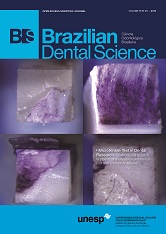909 - Development of Candida albicans biofilm in acrylic resin submitted to treatment with plant extracts
DOI:
https://doi.org/10.14295/bds.2013.v16i3.909Resumo
Objective: To evaluate the antifungal potential of Equisetum arvense L. (horsetail), Glycyrrhiza glabra L. (licorice), Punica granatum L. (pomegranate) and Stryphnodendron barbatimam Mart. (barbatimão) extracts, after Candida albicans biofilm formation on acrylic resin. Material and methods: C. albicans standard strain was cultured on Sabouraud-dextrose agar for 24 h at 37°C. After standardized in a spectrophotometer, 100 µL of the inoculum (106 cells/mL) and a sterile acrylic resin disc were maintained in Brain Heart Infusion broth supplemented with sucrose (5%), for 5 days at 37ºC. The samples of the treated groups (n = 10) were separately exposed to a concentration of 50 mg/mL of each extract for 5 minutes or to nystatin (48.83 IU/mL). For the untreated group (control, n = 10) was used sterile saline (0.9% NaCl). Biofilms were disaggregated of the acrylic resin discs by an ultrasonic homogenizer for 30 s. After decimal dilutions, sowings in Sabouraud-dextrose plates were made with incubation for 48 h at 37°C. Later, CFU/mL was counted and the values were converted to log10 and had their statistical analysis done (ANOVA and Tukey Test, p ? 0.05). Results: It was found that all plant extracts and nystatin resulted in significant C. albicans biofilm reduction (p < 0.01) compared to the control group (0.9% NaCl). However, all of them showed similar reductions to each other (p = 0.1567). Conclusion: There was biofilm formation of C. albicans on acrylic resin and all plant extracts were effective against this yeast, acting similarly to nystatin.Downloads
Downloads
Arquivos adicionais
Publicado
Como Citar
Edição
Seção
Licença
TRANSFERÊNCIA DE DIREITOS AUTORAIS E DECLARAÇÃO DE RESPONSABILIDADE
Toda a propriedade de direitos autorais do artigo "____________________________________________________________________" é transferido do autor(es) para a CIÊNCIA ODONTOLÓGICA BRASILEIRA, no caso do trabalho ser publicado. O artigo não foi publicado em outro lugar e não foi submetido simultaneamente para publicação em outra revista.
Vimos por meio deste, atestar que trabalho é original e não apresenta dados manipulados, fraude ou plágio. Fizemos contribuição científica significativa para o estudo e estamos cientes dos dados apresentados e de acordo com a versão final do artigo. Assumimos total responsabilidade pelos aspectos éticos do estudo.
Este texto deve ser impresso e assinado por todos os autores. A versão digitalizada deverá ser apresentada como arquivo suplementar durante o processo de submissão.




























